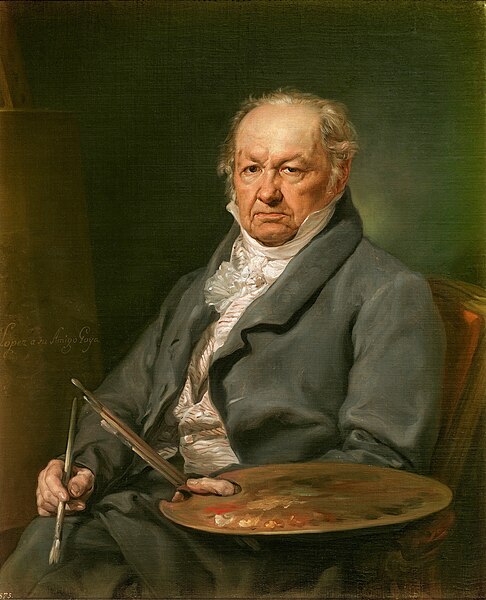
Born: 30 March 1746, Fuendetodos, Aragon
Died: 16 April 1828 (aged 82)
Period: Romanticism
The Life of Francisco de Goya
Francisco José de Goya y Lucientes was a Spanish painter and printmaker, widely regarded as one of the most important Spanish artists of the late 18th and early 19th centuries. Goya’s work is celebrated for its revolutionary approach to depicting the human condition, marking a bridge between the Old Masters and the modern art movements that would follow.
Born in Fuendetodos, Spain, Goya moved to Zaragoza with his family during his childhood. He began his art studies at a young age, later moving to Madrid to further his education. In his early career, Goya achieved success as a painter in the Rococo style, producing tapestry cartoons for the Royal Tapestry Factory, which depicted lively and charming scenes of everyday life.
Goya’s style evolved significantly over the years. By the 1780s, he had become a court painter to the Spanish Crown, where he created portraits of the Spanish nobility with a keen eye for psychological insight and realism, setting him apart from his contemporaries. His work during this period reflects a critical engagement with social and political issues, a trend that would become more pronounced in his later works.
The Peninsular War (1808–1814) and the subsequent political turmoil had a profound effect on Goya. His series of etchings, “The Disasters of War,” unflinchingly documents the horrors of the conflict and its aftermath, showcasing Goya’s disillusionment with the human capacity for violence and his empathy for the suffering of individuals. This period marked a turning point in his work, leading to darker themes and a focus on the fantastical and grotesque, as seen in his “Black Paintings,” a series of murals painted directly onto the walls of his house, Quinta del Sordo (House of the Deaf Man), which depict haunting, nightmarish visions.
In his later years, Goya lived in self-imposed exile in Bordeaux, France, due to his disillusionment with the political situation in Spain and concerns for his personal safety. Despite his age and health problems, he continued to work, experimenting with lithography and producing a series of works that reflected his ongoing interest in social commentary, portraiture, and the human psyche.
Goya died in 1828 in Bordeaux. His legacy is immense, influencing generations of artists and establishing him as a pivotal figure in the transition from the old artistic traditions to the new. His ability to capture the complexities of human nature, combined with his innovative techniques and bold use of subject matter, make him a seminal figure in the history of Western art.
Francisco de Goya’s Notable Works
Francisco de Goya is renowned for his profound influence on art, capturing the tumult of his times and pioneering modern artistic expressions. His most famous works span a range of genres, from portraiture to social commentary, and include:
- “The Third of May 1808” (1814) – This painting dramatically depicts the execution of Spanish insurgents by French soldiers during the Peninsular War, highlighting the brutality of war and the heroism of the victims.
- “Saturn Devouring His Son” (c. 1819-1823) – Part of the Black Paintings series, this haunting image represents the mythological figure Saturn (Chronos) consuming one of his children, symbolizing the destructive forces of time and decay.
- “The Sleep of Reason Produces Monsters” (c. 1797-1799) – From “Los Caprichos,” this etching and aquatint is a critical commentary on Spanish society, illustrating how the absence of rationality leads to chaos and suffering.
- “The Naked Maja” (c. 1797-1800) and “The Clothed Maja” (c. 1800-1803) – These two paintings, portraying the same woman nude and clothed, respectively, are celebrated for their sensuality, mystery, and the controversy they sparked due to their provocative nature.
- “The Family of Charles IV” (1800) – This royal portrait is notable for its unflinching realism, with Goya offering a candid, almost critical depiction of the Spanish royal family.
- “Witches’ Sabbath” (c. 1820-1823) – Another from the Black Paintings series, this work depicts a coven of witches, showcasing Goya’s fascination with the dark and supernatural.
- “The Colossus” (c. 1808-1812) – Often interpreted as a symbol of the Spanish resistance against Napoleon’s armies, this painting features a giant towering over a landscape of panic and turmoil.
- “The Shootings of May Third 1808” (1814) – This dynamic and emotional painting captures the horror of the executions carried out by Napoleon’s forces in Madrid, a companion piece to “The Third of May 1808.”
- “La Maja Vestida” and “La Maja Desnuda” – These paintings are famous for their daring depiction of the female form, with the identity of the subject and the boldness of the portrayal sparking much debate.
- “Witches’ Flight” (c. 1797-1798) – From “Los Caprichos,” this etching illustrates the superstitious beliefs of the time, with figures soaring through the air, suggesting the power of irrational fears and imagination.
Goya’s oeuvre is a testament to his innovative spirit and his keen observation of the human condition, blending realism with the fantastical to explore the depths of society, politics, and personal despair.